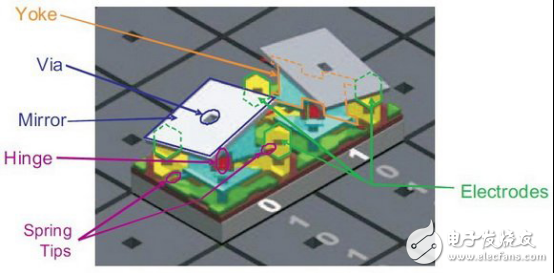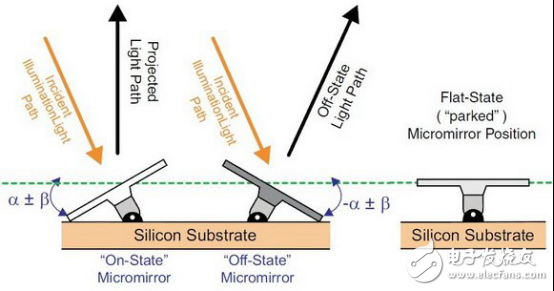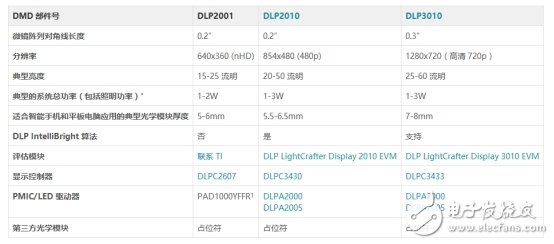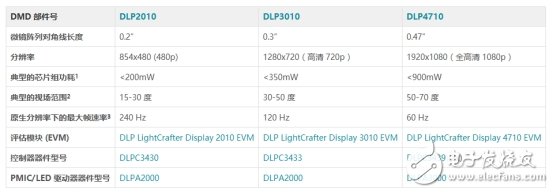DLP stands for Digital Light Processing, which means digital optical processing technology in Chinese, and the core of DLP is the DMD chip. The DMD chip is a data micromirror device, which realizes the purpose of displaying the projected image by controlling the deflection of light by the microlens. DLP technology is different from what we usually say about large screens, flat panel displays, and LCD liquid crystal displays. It is a front-projection (also called front-projection) system, which is mainly used in micro-projection products on the market today, mainly involving 3D stereo projector , Mobile high-definition video products, portable LED micro-projection applications (such as handheld, pocket), and so on. According to the internal structure of the product, DLP projectors can be divided into single-chip DLP projectors, dual-chip DLP projectors and three-chip DLP projectors.
DLP technology is a light projection display technology independently developed by Texas Instruments (TI), developed by Dr. Larry Hornbeck of Texas Instruments. In the early years, DMD chips were mainly used in ticket printing machines. It was not until 1993 that this optical system with DMD as its core was named DLP.
The working principle of DMD chip:

DMD chip internal structure diagram
Micromirror
In the DMD chip, the micro-mirror is its smallest unit of work, and it is also the key to its performance. The micro-mirror is very small, but still has a complicated mechanical structure different from liquid crystal-each micro-mirror has an independent support frame and is deflected by +/- 12 ° around the hinged inclined axis. For micro-mirrors such as micro-mirrors, traditional mechanical or hydraulic controls are no longer available (even if they can be used, they will be quickly damaged due to mechanical wear), so two electrodes are arranged at the two corners of the micro-mirror. Control and control the deflection to obtain high-precision control capability and unlimited polarization life.

When DMD works, each micro-mirror deflects at +/- 12 °
Micromirror working diagram
The micro-mirror works by reflecting light, and its deflection ability is the key. As shown in the figure above, this is a working diagram of a micro-mirror with a deflection angle of +/- 12 °. When the micro-mirror is turned on (On State, + 12 °), the incident angle of the incident light (light source) reaches 12 °, and the reflection angle also reaches 12 ° (the sum of the two is 24 °). At this time, the maximum light energy is (255,255,255); The micro-mirror is biased off (Off State, -12 °). At this time, the light received by the lens is getting smaller and smaller. When reaching the off state, the brightness is the lowest, which is (0, 0, 0).

Working principle of DMD micro reflector
Texas Instruments DLP Pico projection technology solutions:
As the owner of DLP technology, Texas Instruments launched a DMD chip and corresponding video processing chip for the projection market, a series of DLP product solutions called DLP Pico display technology. Texas Instruments does not manufacture DLP projectors, only DLP Pico chipsets, mainly including two devices: digital micromirror device (DMD) and display controller. Some chipsets also include PMIC / LED drivers. For different applications of DLP micro-projection technology, Texas Instruments launched mainly suitable for mobile portable devices such as smart phones, tablets, high-definition / full-HD Pico projectors, wearable devices such as helmets, headphones and glasses, smart home displays, digital signage, Comprehensive solutions for multiple DLP Pico chipsets such as mobile smart TVs.

Texas Instruments DLP product series for mobile and portable products

Texas Instruments' DLP product family for micro projectors

Texas Instruments DLP product line for wearables
In response to the problem of low color saturation and low brightness of DLP projectors, Texas Instruments also introduced the "Extreme Color" technology, which uses DDR chips to replace the changes in SDR chipsets to achieve enhanced image color processing. Simply put, the ultimate color technology is to use a color wheel that combines three primary colors and three complementary colors, and an appropriate color matching algorithm circuit to achieve the purpose of improving the color display capability of the single-chip DLP projector. In response to this concept of Texas Instruments, the color wheel of the ultimate color technology designed by various DLP projector manufacturers according to different situations is also different, so the image quality will also be quite different.
At present, for the mainstream display technology in the projection market, there are DLP projectors that use traditional LCD liquid crystal display projectors, micro-projection technologies, and 3LCD projection technologies that are said to have good effects on color saturation and contrast. Most non-Japanese projector brands use DLP projection technology, and among Japanese brands including Mitsubishi Electric, Hitachi, Sharp and other brands, DLP projectors also occupy a more important position.
Let's briefly understand some of the common DLP brands in the projector market and the advantages of integrating DLP technology. We have launched targeted DLP series development tools (Texas DLP LightCrafter evaluation module) and DLP finished product integration solutions.
Power Adapter,Universal Power Adapter,Usb Power Adapter,67W Usb-C Power Adapter
Guang Er Zhong(Zhaoqing)Electronics Co., Ltd , https://www.geztransformer.com